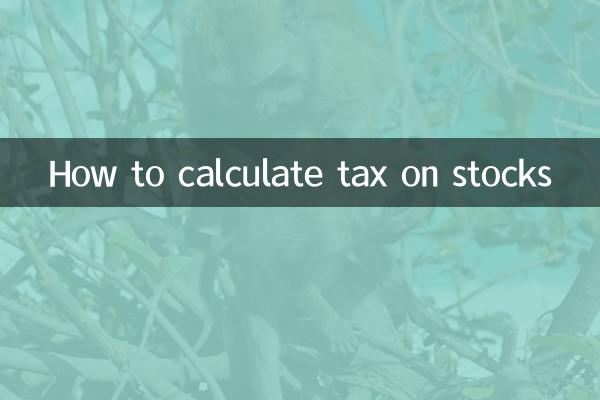How to calculate tax on stocks
In recent years, with the active stock market, more and more investors have begun to pay attention to the tax issues of stock transactions. Whether short-term trading or long-term holding, it is crucial for investors to understand how taxes are calculated on stocks. This article will introduce in detail various tax calculation methods in stock trading, and attach a structured data table to help you understand at a glance.
1. Types of taxes and fees involved in stock transactions

Stock trading mainly involves the following types of taxes:
| Types of taxes and fees | Collection objects | Tax rate/rate | Remark |
|---|---|---|---|
| stamp duty | seller | 0.05% | Only levied on selling stocks |
| commission | buyers and sellers | 0.03%-0.3% | Charged by the brokerage, minimum 5 yuan |
| Transfer fee | buyers and sellers | 0.001% | Charges for stocks on the Shanghai Stock Exchange and exemption on the Shenzhen Stock Exchange |
| personal income tax | seller | 20% | Only taxed on dividends |
2. Specific calculation of stock transaction taxes and fees
The following is a specific calculation example. Suppose you buy and sell 1,000 shares of a Shanghai stock market at a price of 10 yuan per share:
| Transaction link | Expense items | Calculation formula | Amount (yuan) |
|---|---|---|---|
| buy | Commission (calculated as 0.1%) | 1000 shares×10 yuan×0.1% | 10 |
| Transfer fee | 1000 shares×10 yuan×0.001% | 0.1 | |
| total | - | 10.1 | |
| sell | Commission (calculated as 0.1%) | 1000 shares×10 yuan×0.1% | 10 |
| Transfer fee | 1000 shares×10 yuan×0.001% | 0.1 | |
| stamp duty | 1000 shares×10 yuan×0.05% | 5 | |
| total | - | 15.1 | |
| total transaction cost | 25.2 |
3. Tax treatment of dividends
If the stocks you hold pay dividends, you also need to pay attention to the following tax regulations:
| Holding time | tax rate | Remark |
|---|---|---|
| Within 1 month | 20% | Full tax |
| 1 month to 1 year | 10% | halved collection |
| More than 1 year | 0% | exempt from tax |
4. Tax optimization suggestions
1.long term holding: If you hold stocks for more than 1 year, you can be exempted from dividend tax. At the same time, reducing the frequency of transactions can also reduce commissions and stamp duty expenses.
2.Make reasonable use of tax exemption quota: Currently, individual investors have a dividend tax-free limit of 10,000 yuan per year, and can reasonably arrange their investment portfolios.
3.Choose a low commission broker: The commission rates of different brokers vary greatly. Choosing a low-rate broker can significantly reduce transaction costs.
4.Pay attention to policy changes: Tax policies may be adjusted. Keeping abreast of the latest policies will help with tax planning.
5. Summary
Although the calculation of taxes and fees for stock transactions may seem complicated, as long as you master the basic rules, you can be aware of it. This article uses a structured table to demonstrate the calculation methods of major taxes and provides tax optimization suggestions, hoping to help you invest in stocks more efficiently. Remember, sound tax planning is also an important part of investing success.

check the details

check the details